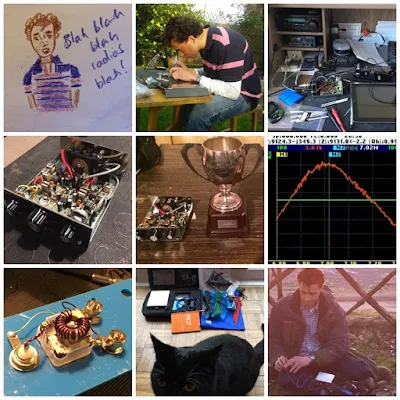Dear Bill
I write this to you from my shack in Wimbledon, south west London, with the crackle of the bands slowly waking up across Europe, having just devoured the final few pages of your excellent Soldersmoke book; an intriguing and entertaining tale to which many of us can relate, a highly-accessible technical primer which certainly helped me to clarify a few niggling “Yes, but why?” questions, and a compendium of handy tricks to try during future projects – thank you for sharing your story.
I was amused to read that GB2RN, on HMS Belfast in London, where I am now one of the “new boy” volunteers, was an inaugural contact for your Azorean 17m DSB rig. As it turns out, 12000 tonnes of British warship seems to play an crucial role in testing QRP radios:
Enjoying a peaceful hilltop picnic in December 2014 with my girlfriend, gazing out over the idyllic Italian countryside above Frascati, it occurred to me that what the situation really called for was a 40m QRP CW transceiver (I was possibly alone in this thought). Soon after returning home I set about researching small, reliable kits which could slip into my jacket pocket but still tune across the band.
The EGV-40 (in memory of Miguel EA3EGV, EA-QRP co-founder) seemed ideal: a “tutti frutti” architecture of well-proven designs, based around a VXO for high stability.
My construction schedule was leisurely, paced for enjoyment and attention to detail. At all times I looked to maximise reliability, crucial when operating from a hilltop, far from a workbench. To pre-harmonise the radio with an outdoor life, on sunnier occasions I often found myself soldering in the garden. For a personal touch, I made sure to instill plenty of “soul”, reminiscent of my electronics journey so far: my late grandfather's tools and solder were used throughout, alongside my own, together with reclaimed parts from old school projects and my elmer’s junk box; finally, in a shameless attempt at appeasement, my remarkably understanding girlfriend even helped to solder the final capacitor… and may be invited to recommend the paint colour!
In mid-December 2015 we once again flew out to Rome for our pre-Christmas break. Our first day was spent exploring the stunning Villa D'Este (stunning to behold, an ideal high radio QTH but far too beautiful for my wires to pollute the scenery without getting into trouble...) and Villa Adriana, near Tivoli. It was only right at the end of the afternoon, and annoyingly lower down towards the plains, when I stopped for a few minutes for an attempted sked with GB2RN.
Lesson 1: trees with lots of branches and twigs are a real pain for throwing wires through! I had guessed this already, but it truly is an exponential problem.
After conquering a geometric puzzle, I had my EFHW strung so that the point of maximum radiation was about 4m in the air – not exactly ideal for DX but theoretically reasonable for a nice high angle of radiation, like I needed. The feed point (fortunately a current null) was at roughly half this… time to get on the air!
Lesson 2: when operating outdoors – beware of the locals!
Rather than a comfortable bench I resorted to operating whilst sitting cross-legged on the grass, balancing my ex-German military miniature key on my thigh as I tapped it with my finger and attempted to steady it with my left hand.
The ambient sound of the 40m band seemed very different in I-land – that was the busiest I'd heard it outside of contests, riddled with deafening Eastern-bloc calls but not a single station from any of the British nations, which I presume must have largely been in the shade of the skip; apart from booming GB2RN beaconing to me high on the band :-)
The Villa closes at 1700 and from past experience the wardens come around at 1630 to chase stragglers out from the far corners. Annoyingly one such woman decided that my guy wire and its supporting tent peg looked highly out of place and must be interfered with. My Italian is woefully incompetent at the best of times, so I resorted to gesticulating at her wildly with my left hand as my right attempted to stay faithful to sending clear CW.
Perhaps it was for the best; had she understood that I was “Making a scheduled contact with a British warship via Morse code using home-built equipment which I had smuggled into the country by air last night", the tale might have taken an entirely different twist...
Cold hands, fading light and a dead leg from sitting in an awkward cross-legged position which is frankly impractical for anybody beyond the age of 8, but I was utterly thrilled to have enjoyed my first QSO from overseas, and particularly so since it was with my Elmer on the ship using a station which I had diligently put together myself over a number of months.
The first wisps of solder smoke have already left my iron this morning as I embark on the next stage of my QRP apprenticeship – to make the jump from a kit operator to a scratch-built home brew. All my life I have yearned to understand from first principles, and our remarkable hobby offers us a unique privilege to do so whilst sharing experience along the way.
Our objectives are decidedly more modest in scale, but I’m often reminded of President Kennedy’s famous quote: "We choose to go to the Moon in this decade and do the other things, not because they are easy, but because they are hard”.
72/3
Jonathan
M0JGH
PS Should you or any of the Soldersmoke brotherhood ever be in London and wish to operate from GB2RN, please don’t hesitate to contact me.









































